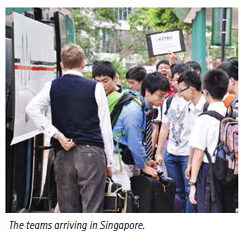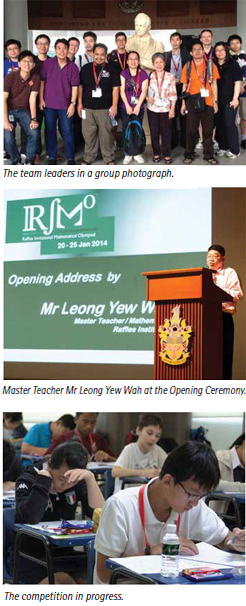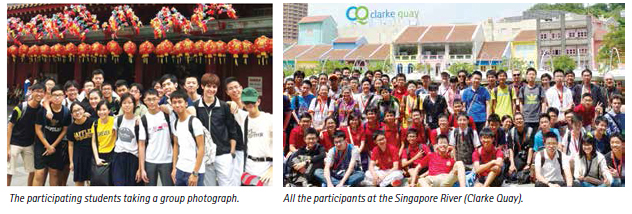|
by Inez Tan
 
 he 2014 Raffles Invitational Mathematical Olympiad (RIMO) was held from 20 to 25 January 2014. A biennial event which started in 2012, the RIMO serves as a platform where students between Grade 7 to 10 (Secondary 1 to 4) with a penchant for math can challenge themselves and make like-minded friends from different cultural backgrounds. The aim of this event was to foster friendly international relations between students and teachers from schools from around the world that were characterized by a strong commitment to the pursuit of mathematics. It also provided opportunities for participants to build friendships with their counterparts from different countries as well as share and learn from each other. Nine local teams and eleven international teams from schools in China, France, Hong Kong, Malaysia and Thailand took part this year. he 2014 Raffles Invitational Mathematical Olympiad (RIMO) was held from 20 to 25 January 2014. A biennial event which started in 2012, the RIMO serves as a platform where students between Grade 7 to 10 (Secondary 1 to 4) with a penchant for math can challenge themselves and make like-minded friends from different cultural backgrounds. The aim of this event was to foster friendly international relations between students and teachers from schools from around the world that were characterized by a strong commitment to the pursuit of mathematics. It also provided opportunities for participants to build friendships with their counterparts from different countries as well as share and learn from each other. Nine local teams and eleven international teams from schools in China, France, Hong Kong, Malaysia and Thailand took part this year.
The international teams touched down on 20 January, and started the next day with a tour of the Raffles Institution (RI) Campus. This was followed by the Opening Ceremony, where RI’s best performing groups showcased their talents. The Guest-of-Honor at the Opening Ceremony was Master Teacher Mr Leong Yew Wah, who spoke about how the competition “uses mathematics as the connecting subject to gather great mathematical minds around the world to engage in healthy competition and connect with each other”.
Mr Leong also set the tone of the Opening Ceremony by sharing a couple of interesting math jokes which got the audience laughing:
Student participants also got to know each other better before settling down to face two grueling days of math tests, where they competed in a series of Olympiad-style questions that required them to apply and demonstrate mathematical concepts and creativity in problem-solving.
Nine gold, 21 silver and 29 bronze medals were given out on the fifth day of the event. No 1 Middle School attached to Central China National University successfully defended their Championship, with Rao Zheng Hao (No 1 Middle School attached to Central China National University) emerging Top Boy and Wong Sze Nga (The Hong Kong Academy for Gifted Education) winning Top Girl.
 All in all, RIMO involved more than just battles with numbers, but also an opportunity for the international delegates to make friends and learn about Singapore. The teams found time to visit the River Safari – a newly-opened attraction at the Singapore Zoo, Clarke Quay, Chinatown and the East Coast Park. It was truly an enjoyable time for everyone, especially the international participants. Most were visiting Singapore for the first time, and left with a positive first impression of a clean, modern, green and friendly city. While the RIMO was conceived as an Asian competition to bring together the best math talent of the age-group here at Raffles Institution, we hope the RIMO will further establish Singapore’s global identity as a country known for nurturing math and science talents. All in all, RIMO involved more than just battles with numbers, but also an opportunity for the international delegates to make friends and learn about Singapore. The teams found time to visit the River Safari – a newly-opened attraction at the Singapore Zoo, Clarke Quay, Chinatown and the East Coast Park. It was truly an enjoyable time for everyone, especially the international participants. Most were visiting Singapore for the first time, and left with a positive first impression of a clean, modern, green and friendly city. While the RIMO was conceived as an Asian competition to bring together the best math talent of the age-group here at Raffles Institution, we hope the RIMO will further establish Singapore’s global identity as a country known for nurturing math and science talents.
Inez Tan is a Communications Executive at Raffles Institution, Singapore.
The questions proved challenging and the students found them fun, stimulating and indeed, thought provoking. Below are some sample questions:
- A positive integer is written on the board. At any time, the positive integer n on the board can be replaced by ab if n = a + b and a, b are positive integers. Determine all possible integers that can be written on the board initially so that 2012 can be obtained at some subsequent step.
- An autobiographical number is a natural number in which the first digit of the number (reading from left to right) tells you how many zeros are in the number, the second digit tells you how many 1’s, the third digit tells you how many 2’s, and so on. For example, 6, 210, 001, 000 is an autobiographical number. Determine the smallest autobiographical number.
- A queue in front of a ticketing counter consists of 13 people. The counter is then closed due to a technical problem and the 13 people are redirected to another queue. Given that each person maintains the same position as before, is one step closer to the front, or is one step further from the front, determine in how many ways this can be done.
- Find the average of all integers n that does not contain the digit 1 and satisfying 0_n_10000.
- Let the vertices of a rectangle in the Cartesian plane be (4,3), (-4,-3), (x1, y1) and (x2, y2), though not necessarily in that order. Suppose that x1, x2, y1 and y2 are integers. How many such rectangles are there with |xi| _ 2014, |yi| _ 2014 for i = 1, 2?
- A sports journalist decides to feature in his upcoming article 7 different soccer players who he thinks contributed significantly to their respective countries’ performance in World Cup 2010:
- Gonzalo Higuain (Argentina)
- Miroslav Klose (Germany)
- Javier Hernandez (Mexico)
- Wesley Sneijder (Netherlands)
- David Villa (Spain)
- Landon Donovan (United States)
- Luis Suarez (Uruguay)
He remembers that they scored 26 goals altogether but he cannot recall how many goals each one of them has scored. If he randomly indicates the number of goals scored for each player, how many different articles can he produce that contain mistakes?
[Note that all the featured players scored at least one goal each]
|
 Click here to download the full issue for USD 6.50 Click here to download the full issue for USD 6.50
|




 he 2014 Raffles Invitational Mathematical Olympiad (RIMO) was held from 20 to 25 January 2014. A biennial event which started in 2012, the RIMO serves as a platform where students between Grade 7 to 10 (Secondary 1 to 4) with a penchant for math can challenge themselves and make like-minded friends from different cultural backgrounds. The aim of this event was to foster friendly international relations between students and teachers from schools from around the world that were characterized by a strong commitment to the pursuit of mathematics. It also provided opportunities for participants to build friendships with their counterparts from different countries as well as share and learn from each other. Nine local teams and eleven international teams from schools in China, France, Hong Kong, Malaysia and Thailand took part this year.
he 2014 Raffles Invitational Mathematical Olympiad (RIMO) was held from 20 to 25 January 2014. A biennial event which started in 2012, the RIMO serves as a platform where students between Grade 7 to 10 (Secondary 1 to 4) with a penchant for math can challenge themselves and make like-minded friends from different cultural backgrounds. The aim of this event was to foster friendly international relations between students and teachers from schools from around the world that were characterized by a strong commitment to the pursuit of mathematics. It also provided opportunities for participants to build friendships with their counterparts from different countries as well as share and learn from each other. Nine local teams and eleven international teams from schools in China, France, Hong Kong, Malaysia and Thailand took part this year.
 All in all, RIMO involved more than just battles with numbers, but also an opportunity for the international delegates to make friends and learn about Singapore. The teams found time to visit the River Safari – a newly-opened attraction at the Singapore Zoo, Clarke Quay, Chinatown and the East Coast Park. It was truly an enjoyable time for everyone, especially the international participants. Most were visiting Singapore for the first time, and left with a positive first impression of a clean, modern, green and friendly city. While the RIMO was conceived as an Asian competition to bring together the best math talent of the age-group here at Raffles Institution, we hope the RIMO will further establish Singapore’s global identity as a country known for nurturing math and science talents.
All in all, RIMO involved more than just battles with numbers, but also an opportunity for the international delegates to make friends and learn about Singapore. The teams found time to visit the River Safari – a newly-opened attraction at the Singapore Zoo, Clarke Quay, Chinatown and the East Coast Park. It was truly an enjoyable time for everyone, especially the international participants. Most were visiting Singapore for the first time, and left with a positive first impression of a clean, modern, green and friendly city. While the RIMO was conceived as an Asian competition to bring together the best math talent of the age-group here at Raffles Institution, we hope the RIMO will further establish Singapore’s global identity as a country known for nurturing math and science talents.
 Click here to download the full issue for USD 6.50
Click here to download the full issue for USD 6.50